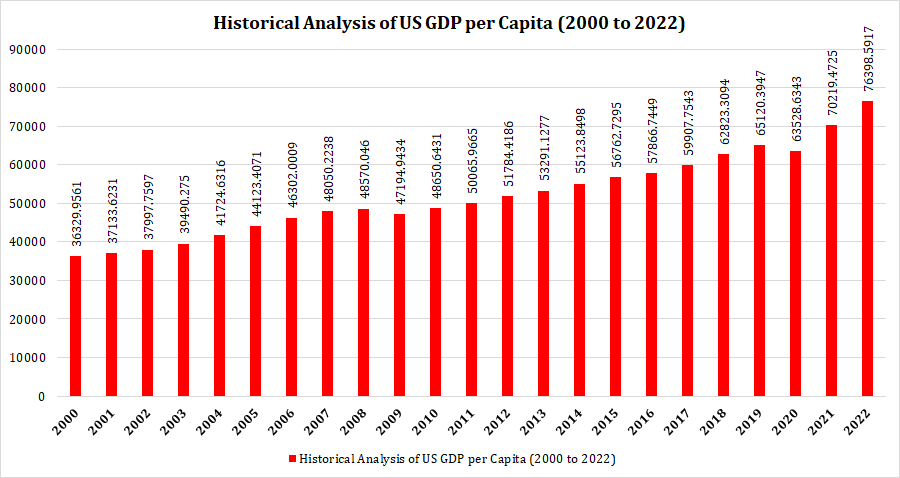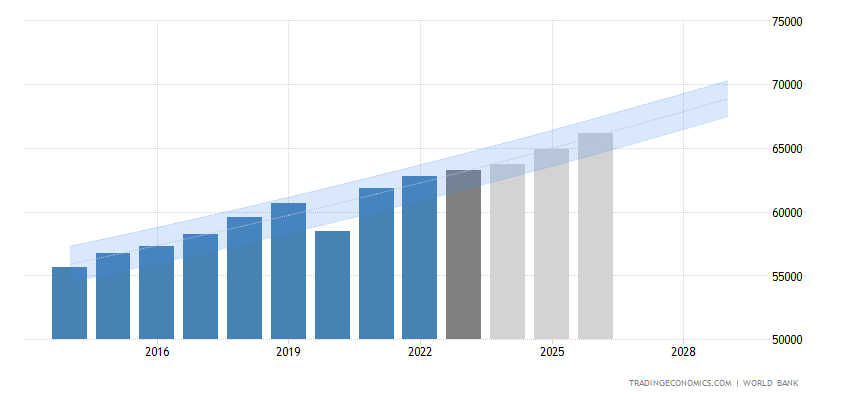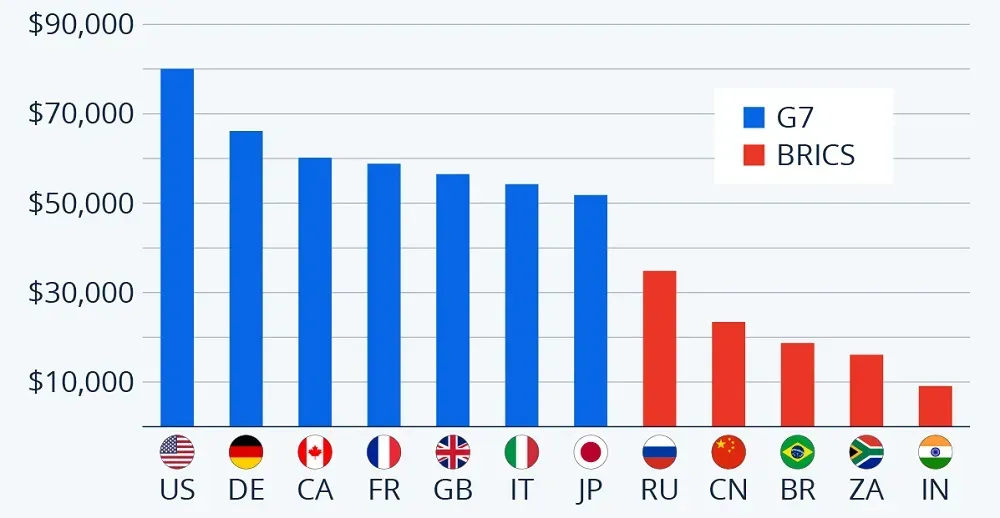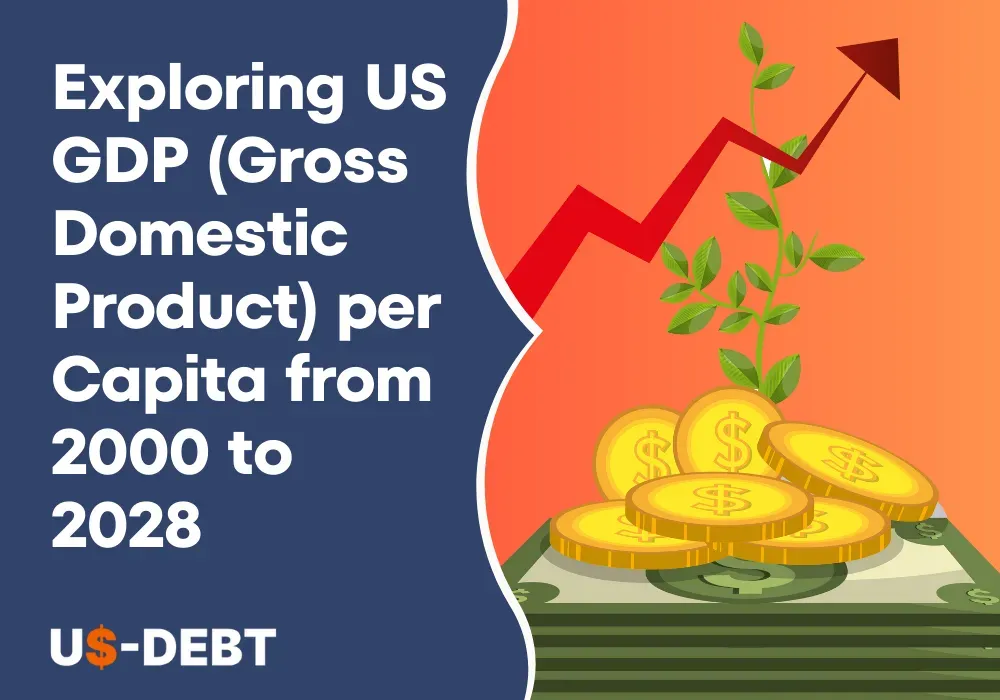The average revenue and standard of life of people living in a nation are estimated by the Gross Domestic Product (GDP) per Capita, a key economic statistic. Understanding the patterns and variations in the US GDP per Capita from 2000 to 2022 offers important insights into the state and forecast for the country's economy. We look at the historical analyses, present-day forecasts, ramifications, and relevance of the US GDP per Capita in this blog article.
Â
US GDP per Capita Overview
To begin, let's establish a clear understanding of GDP and per Capita. GDP is a measure of the entire economic growth of a nation during a certain period, including all commodities and services. Gross domestic product per capita, which enables the determination of GDP per person in a nation, is equal to the yearly GDP divided by the average population from the same year. This calculation helps determine the average income per person.
It is well known that America has the largest economy worldwide but wealth distribution among its populations is not uniform. By studying the US GDP per Capita, we gain insights into the income disparities and the overall well-being of its citizens. Additionally, factors such as employment rates, productivity, government policies, and technological advancements influence the US GDP per Capita.
Â
Historical Analysis of US GDP per Capita (2000 to 2022)

Examining the historical data of the US GDP per Capita from 2000 to 2022 reveals interesting trends and fluctuations. In 2000, the US experienced a GDP per Capita of $36,818, reflecting the average income of its population. Analyzing subsequent years allows us to identify patterns, understand the impact of various events, and assess the economy's resilience.
Over the years, the US detected both growth and decline in its GDP per Capita. Factors such as changes in government policies, shifts in industries, financial crises, and technological advancements played significant roles in shaping these fluctuations. For instance, the COVID-19 pandemic in 2020 had a profound impact on the US economy, causing a temporary decline in the GDP per Capita.
Â
Factors Influencing Changes in US GDP per Capita over Time
GDP per capita is a gauge of a nation's economic production per citizen and is influenced by both economic and non-economic variables. Here are some key factors that can impact changes in US GDP per capita:
Economic Growth: Economic growth, measured by changes in real GDP, plays a significant role in influencing changes in GDP per capita. When the economy experiences robust growth, it generally increases GDP per capita.
Labor Productivity: The productivity of the workforce is an essential factor in determining GDP per capita. When workers are more productive due to advancements in efficiency, technology, or skills, the economy grows and the GDP per capita rises.
Technological Advancements: Technological progress can have a substantial impact on GDP per capita. Automation, artificial intelligence, and innovative manufacturing techniques are examples of innovations that can boost economic production and productivity, ultimately raising GDP per capita.
Investment and Capital Formation: The level of investment in physical capital, such as machinery, infrastructure, and research and development, can influence GDP per capita. Higher levels of investment contribute to increased productivity and economic growth.
Population Growth: Changes in population size can affect GDP per capita. Outpacing economic development, population increase can strain resources and even reduce GDP per capita. Conversely, slower population growth or declining population can lead to higher GDP per capita if economic output remains stable or increases.
Government Policies: Fiscal and monetary policies implemented by the government can impact GDP per capita. For instance, tax policies, government spending, regulations, and interest rate adjustments can influence investment, consumption, and overall economic activity, consequently affecting GDP per capita.
Trade and Global Economic Factors: International trade and global economic conditions can influence GDP per capita. Changes in export levels, import volumes, exchange rates, and global economic trends can affect the performance of domestic industries and overall economic growth.
Education and Human Capital: The level of education and human capital in a country is closely linked to productivity and economic growth. Investments in education and training can improve the workforce's knowledge and skills, increasing GDP per capita.
Natural Resources: The availability and utilization of natural resources can impact GDP per capita, particularly for resource-rich countries. However, extended economic growth depends on the proper use of natural resources.
It is essential to remember how deeply these variables interact and affect one another. Numerous other aspects like geopolitical events, demographic shifts, and environmental problems, can also have a consequence on economic data. Thus, analyzing changes in GDP per capita requires a comprehensive understanding of the broader economic context.
Â
Future Projections for US GDP per Capita (2000 to 2028)

Forecasting the future of the US GDP per Capita requires employing various methods and models that consider economic indicators, historical trends, and external factors. Although predictions are subject to uncertainties, experts have projected a positive growth trajectory for the US GDP per Capita in the coming years. The US GDP per capita is expected to reach $93,260 by 2028, according to the prediction.
But it's crucial to remember that several factors, such as developing technology, trade laws, geopolitical situations, and environmental challenges, might affect these predictions. It will be essential to monitor these elements and make adjustments as necessary to maintain economic development and guarantee a greater quality of life for US residents.
Â
Implications and Significance of US GDP per Capita
The US GDP per Capita has far-reaching implications and significance. It serves as a vital standard to estimate the standard of living and economic progress of the country. A higher GDP per Capita generally indicates greater opportunities, improved access to quality education and healthcare, and enhanced infrastructure. It also influences investment decisions, economic policies, and international competitiveness.
Comparing the US GDP per Capita with that of other countries provides insights into global economic disparities and competitiveness. Such comparisons assist policymakers in identifying areas for improvement and implementing effective strategies to promote inclusive growth.
Â
Comparison of US GDP per Capita with Other G7 Countries
 Source:Â statista.com
Source:Â statista.com
Except for Italy, all seven G7 nations' GDP per capita has grown since 2000. There, it varied during the period, virtually reaching the same level in 2023 as it did in 2000. When we check the purchasing-power-parity (PPP) per capita of all G7 nations, we can get insight that the USA gets the highest point of $65000 in comparison to other nations. Germany, with a PPP GDP per capita of 54,000 dollars, had the second-highest GDP.
Â
Conclusion
In conclusion, the US GDP per Capita is a crucial economic indicator that reflects the average income and standard of living within the country. Through a historical analysis and future projections, we gain valuable insights into the economic trends, fluctuations, and potential growth of the US economy. Monitoring and understanding the US GDP per Capita will help policymakers, economists, and individuals make informed decisions and contribute to the nation's overall prosperity. A strong and sustained GDP per Capita will be crucial in determining how the American economy develops as we navigate the possibilities and challenges of the future.
Read More:Â US National Debt: A Guide to Understand America's Financial Burden

